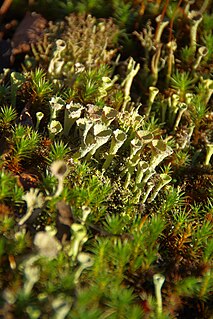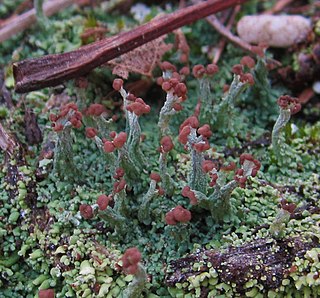
Cladonia rangiferina, also known as reindeer cup lichen, reindeer lichen or grey reindeer lichen, is a light-colored fruticose, cup lichen species in the family Cladoniaceae. It grows in both hot and cold climates in well-drained, open environments. Found primarily in areas of alpine tundra, it is extremely cold-hardy.

Cladonia is a genus of moss-like lichens in the family Cladoniaceae. They are the primary food source for reindeer/caribou. Cladonia species are of economic importance to reindeer-herders, such as the Sami in Scandinavia or the Nenets in Russia. Antibiotic compounds are extracted from some species to create antibiotic cream. The light green species Cladonia stellaris is used in flower decorations.

The Cladoniaceae are a family of lichenized fungi in the order Lecanorales. It is one of the largest families of lichen-forming fungi, with about 560 species distributed amongst 17 genera. The reindeer moss and cup lichens (Cladonia) belong to this family. The latter genus, which comprises about 500 species, forms a major part of the diet of large mammals in taiga and tundra ecosystems. Many Cladoniaceae lichens grow on soil, but other can use decaying wood, tree trunks, and, in a few instances, rocks as their substrate. They grow in places with high humidity, and cannot tolerate aridity.

Cladonia stellaris or the star-tipped cup lichen is an ecologically important species of cup lichen that forms continuous mats over large areas of the ground in boreal and arctic regions around the circumpolar north. The species is a preferred food source of reindeer and caribou during the winter months, and it has an important role in regulating nutrient cycling and soil microbiological communities. Like many other lichens, Cladonia stellaris is used by humans directly for its chemical properties, as many of the secondary metabolites are antimicrobial, but it also has the unique distinction of being harvested and sold as 'fake trees' for model train displays. It is also used as a sound absorber in interior design.

Cladonia parasitica, commonly known as the fence-rail cladonia, fence-rail cup lichen or parasite club lichen, is a species of fruticose, cup lichen in the family Cladoniaceae. It was first described by Hoffmann in 1784 under the name Lichen parasiticus, until he reclassified it under the genus Cladonia in 1795.

Cladonia borealis, commonly known as the boreal cup lichen, is a species of lichen in the genus Cladonia.

Cladonia arbuscula or the shrubby cup lichen is a species of cup lichen in the Cladoniaceae family.

Cladonia carneola or the crowned cup lichen is a species of fruticose, cup lichen in the family Cladoniaceae. It was described as a new species by Swedish mycologist Elias Magnus Fries. Lichenicolous fungi that have been recorded growing on Cladonia carneola include Phaeopyxis punctum and Taeniolella beschiana.

Cladonia digitata, commonly known as the finger cup lichen, is a cup lichen species in the family Cladoniaceae.

Cladonia uncialis is a species of fruticose, cup lichen in the family Cladoniaceae. It was first described as a new species by Swedish taxonomist Carl Linnaeus in 1753. It was transferred to the genus Cladonia by Friedrich Heinrich Wiggers in 1780. In North America, the lichen is colloquially known as the thorn Cladonia or the thorn cup lichen.

Cladonia macilenta or the lipstick cup lichen is a species of cup lichen in the family Cladoniaceae.

Cladonia peziziformis or the turban cup lichen is a species of cup lichen in the family Cladoniaceae.
Lichenosticta is a genus of fungi of uncertain familial placement in the order Lecanorales. It has five species. All species are lichenicolous, meaning they are parasitic on lichens.
Lichenopeltella uncialicola is a species of fungus belonging to the class Dothideomycetes. The species was discovered in Iceland in 2010 where it was found growing on Cladonia uncialis. Since then, it has been found on a different host species, Cladonia rangiferina, in North-Korea, Italy Austria, and Greenland.
Lichenoconium pyxidatae is a species of lichenicolous fungus belonging to the class Dothideomycetes. It has a Holarctic distribution being found in Alaska and various parts of Russia, including Siberia, Franz Josef Land, Novaya Zemlya and Wrangel Island.
Zhurbenkoa is a genus of lichenicolous fungi in the family Malmideaceae. It has three species. The genus was circumscribed in 2019 by Adam Flakus, Javier Etayo, Sergio Pérez-Ortega, and Pamela Rodriguez-Flakus, with Zhurbenkoa epicladonia assigned as the type species. Closely related genera are Savoronala and Sprucidea. The generic name honours Russian lichenologist Mikhail Zhurbenko, "for his magnificent contribution to knowledge on the biodiversity and systematics of lichenicolous fungi, including lichen parasites colonizing Cladonia".

Cladonia rei, commonly known as the wand lichen, is a species of ground-dwelling, fruticose lichen in the family Cladoniaceae. It is a widely distributed species, having been reported from Africa, Asia, Australasia, Europe, and North America. It is identified by its slightly dirty-colored, rough-surfaced, slender podetia that grow up to 9 cm (3.5 in) tall. Diagnostic characters of the lichen include the continuously sorediate, green-and-brown-mottled, podetia that taper upward to a point, while chemically, it contains homosekikaic and sekikaic acids. Its reduced capacity to bioaccumulate toxic heavy metals from its surroundings, as well as its ability to switch photobiont partners, allows the lichen to colonize and survive highly polluted habitats. There are several other Cladonia species that are somewhat similar in appearance, but can be distinguished either by subtle differences in morphology, or by the secondary chemicals they contain.
Sphaerellothecium araneosum is a species of lichenicolous fungus in the family Phyllachoraceae.

Cladonia pocillum is a species of fruticose, cup lichen in the family Cladoniaceae. It was first formally described as a new species in 1803 by Swedish botanist Erik Acharius as Baeomyces pocillum but in 1877 it was transferred the genus Cladonia by Olivier Jules Richard.
Polycoccum laursenii is a species of lichenicolous fungus in the family Polycoccaceae. It was first described as a new species in 2004 by Russian mycologist Mikhail Petrovich Zhurbenko. It is found in Alaska and in Russia.














